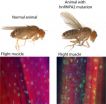(Press-News.org) If the word's nations are going to prevent tobacco smoking from causing one projected billion deaths by the end of this century, they must:
Make tobacco control part of the agendas of United Nation's and other development agencies worldwide;
Assure every sector of a nation including health, trade and finance officials work collectively to protect not only health but the harm tobacco places on their economy by passing laws to reduce use;
Place health as the centerpiece of any decision on a trade treaty that includes tobacco;
Diligently work toward a goal of reducing the prevalence rate of smoking to less than five percent world-wide by 2048, basically ending its use.
Those were among the key recommendations to come out of an international gathering last week at Harvard University of public health officials, academics, and public health advocates from more 40 nations, and such international organizations as the European Union, the African Union, the World Trade Union, and the World Health Organization.
"The only entity in the world to benefit if tobacco use is passed down to the next generation of poor children of the world will be the tobacco industry," warned Gregory Connolly, chair of the meeting and director of the Center for Global Tobacco Control at the Harvard School of Public Health (HSPH). Harvard School of Public Health. "All other industries producing good products and services will suffer, not benefit, and the same is true for the economies of poor nations and their citizens," if smoking is not snuffed out. This meeting was an historic step to make global smoking history," said who two decades ago crafted Massachusetts's tobacco control efforts.
And Dr. Douglas Webb of United Nations Development Program warned that "tobacco use poses a major health and human development threat. Avoidable and unnecessary, tobacco-linked illnesses strike people in their prime, hit the poorest hardest, inhibit country productivity, burden already weak healthcare systems, and consume scarce national resources."
Sponsors of the unusual two-day conference on "Governance of Tobacco in the 21st Century," at Harvard's Radcliffe Institute for Advanced Studies, included WHO, the Harvard Global Health Institute, the American Cancer Society, and the Institute of Global Tobacco Control, at Johns Hopkins University.
Meeting attendees were warned by speaker after speaker that unless there is a concerted international effort now, the plague of tobacco smoking that has claimed 100 million lives in the Developed Nations, will claim a billion in the Developing Nations, where smoking has yet to take hold as it did during the last century in the U.S. and other Developed nations.
But though the situation was described as dire, many nations present showed unity in passing tough national laws based on the World Health Organization Framework Convention on Tobacco Control (FCTC) and demonstrated clear evidence of the scientific effectiveness of the FCTC in reducing use.
Dimitry Yanin of Russia announced that Russian President Vladimir Putin banned smoking in all public places beginning this past June 2013. The legislation will also restrict cigarette sales and ban advertising and sponsorship of events by tobacco companies;
H.E. Nicola Roxon, MP, and Former Attorney General and Minister of Health of Australia, reminded delegates to the that the Australian Supreme Court recently upheld legislation requiring plain pack cigarette packaging;
Dr. Eduardo Bianco of Uruguay presented data on the sharp decline in smoking through the adoption of comprehensive tobacco control measures recommended by the WHO. The decline in Uruguay is comparable to that seen a decade ago in Massachusetts, where smoking is now a rarity, said MIT professor Jeffry Harris, who has evaluated both programs;
Dr. Debby Sy, of the Philippines presented data on that nation's recent successful efforts to greatly increase taxes on tobacco products, despite intense opposition from multi-national tobacco companies;
And Dr. Bernard Merkel of the European Union described the EU's new proposed directive that would allow EU nations to adopt plain packaging, high taxation, smoke-free public places and proven measures.
###
Other sponsors of the meeting included the American Legacy Foundation, the World Health Organization, the International Development Research Centre, the Medical University of South Carolina, the International Tobacco Control Policy Evaluation Project, at the University of Waterloo, the O'Neill Institute for National and Global Health Law, at Georgetown University, the Framework Convention Alliance of Action on Smoking and Health, the Campaign for Tobacco-Free Kids, and the Southeast Asia Tobacco Alliance.
A billion deaths from tobacco are a key obstacle to global development
Global health leaders gathered at Harvard University conclude
2013-03-04
ELSE PRESS RELEASES FROM THIS DATE:
Was King Richard III a control freak?
2013-03-04
University of Leicester psychologists have made an analysis of Richard III's character – aiming to get to the man behind the bones.
Professor Mark Lansdale, Head of the University's School of Psychology, and forensic psychologist Dr Julian Boon have put together a psychological analysis of Richard III based on the consensus among historians relating to Richard's experiences and actions.
They found that, while there was no evidence for Shakespeare's depiction of Richard III as a psychopath, he may have had "intolerance to uncertainty syndrome" – which may have manifested ...
International aid and advocacy groups are influenced by their home countries' cultures
2013-03-04
In February, Greenpeace activist and actress Lucy Lawless, star of "Xena: Warrior Princess," was sentenced to 120 hours of community service for boarding a Shell oil rig to protest offshore Arctic drilling. Dramatic protests by Netherlands-based Greenpeace contrast sharply with the lobbying and letter-writing of the U.S.-based Sierra Club. The differences among those two groups and other international non-governmental organizations (INGOs) reflect the cultures of the nations where they are based, according to research by a University of Missouri political scientist. Individuals ...
Vortex loops could untie knotty physics problems
2013-03-04
University of Chicago physicists have succeeding in creating a vortex knot—a feat akin to tying a smoke ring into a knot. Linked and knotted vortex loops have existed in theory for more than a century, but creating them in the laboratory had previously eluded scientists.
Vortex knots should, in principle, be persistent, stable phenomena. "The unexpected thing is that they're not," said Dustin Kleckner, a postdoctoral scientist at UChicago's James Franck Institute. "They seem to break up in a particular way. They stretch themselves, which is a weird behavior."
This behavior ...
Solutions Real Estate's Massive Success and Continued Growth is the Hottest Topic in San Diego Real Estate News Today
2013-03-04
Matt Johnson fell in love with San Diego in 1998, and has resided here ever since.
He is familiar with the local neighborhoods inside and out, and has the ability to assist you in selecting the best one for your family's needs.
Matt got his start in real estate at the age of 9, helping his Dad turn dilapidated old houses into the gem of the neighborhood. He later continued on that tradition, becoming a professional home renovator with operations in two states. Several years later, he realized his passion was in the sales and marketing side, so he obtained his license ...
Researchers discover how to shutdown cancer's powerful master protein
2013-03-04
NEW YORK (March 3, 2013) -- The powerful master regulatory transcription factor called Bcl6 is key to the survival of a majority of aggressive lymphomas, which arise from the B-cells of the immune system. The protein has long been considered too complex to target with a drug since it is also crucial to the healthy functioning of many immune cells in the body, not just B cells gone bad.
But now, in the journal Nature Immunology, researchers at Weill Cornell Medical College report that it is possible to shut down Bcl6 in the cancer, known as diffuse large B-cell lymphoma ...
7 genetic risk factors found to be associated with common eye disorder
2013-03-04
An international group of researchers has discovered seven new regions of the human genome—called loci—that are associated with increased risk of age-related macular degeneration (AMD), a leading cause of blindness. The AMD Gene Consortium, a network of international investigators representing 18 research groups, also confirmed 12 loci identified in previous studies. The findings are reported online today in the journal Nature Genetics. Supported by the National Eye Institute (NEI), a part of the National Institutes of Health, the study represents the most comprehensive ...
Scientists identify 'clean-up' snafu that kills brain cells in Parkinson's disease
2013-03-04
March 3, 2013— (Bronx, NY) — Researchers at Albert Einstein College of Medicine of Yeshiva University have discovered how the most common genetic mutations in familial Parkinson's disease damage brain cells. The study, which published online today in the journal Nature Neuroscience, could also open up treatment possibilities for both familial Parkinson's and the more common form of Parkinson's that is not inherited.
Parkinson's disease is a gradually progressing disorder of the nervous system that causes stiffness or slowing of movement. According to the Parkinson's ...
Adding to the list of disease-causing proteins in brain disorders
2013-03-04
PHILADELPHIA – A multi-institution group of researchers has found new candidate disease proteins for neurodegenerative disorders. James Shorter, Ph.D., assistant professor of Biochemistry and Biophysics at the Perelman School of Medicine, University of Pennsylvania, Paul Taylor, M.D., PhD, St. Jude Children's Research Hospital, and colleagues describe in an advanced online publication of Nature that mutations in prion-like segments of two RNA-binding proteins are associated with a rare inherited degeneration disorder affecting muscle, brain, motor neurons and bone (called ...
Getting around the Uncertainty Principle
2013-03-04
Researchers at the University of Rochester and the University of Ottawa have applied a recently developed technique to directly measure for the first time the polarization states of light. Their work both overcomes some important challenges of Heisenberg's famous Uncertainty Principle and also is applicable to qubits, the building blocks of quantum information theory.
They report their results in a paper published this week in Nature Photonics.
The direct measurement technique was first developed in 2011 by scientists at the National Research Council, Canada, to measure ...
Cancer vaccines self-sabotage, channel immune attack to injection site
2013-03-04
HOUSTON – Cancer vaccines that attempt to stimulate an immune system assault fail because the killer T cells aimed at tumors instead find the vaccination site a more inviting target, scientists at The University of Texas MD Anderson Cancer Center report in Nature Medicine.
A common substance used in many cancer vaccines to boost immune attack betrays the cause by facilitating a buildup of T cells at the vaccination site, which then summon more T cells to help with the perceived threat.
"Vaccines stimulate production of T cells primed to attack the target cancer, and ...
LAST 30 PRESS RELEASES:
Making lighter work of calculating fluid and heat flow
Normalizing blood sugar can halve heart attack risk
Lowering blood sugar cuts heart attack risk in people with prediabetes
Study links genetic variants to risk of blinding eye disease in premature infants
Non-opioid ‘pain sponge’ therapy halts cartilage degeneration and relieves chronic pain
AI can pick up cultural values by mimicking how kids learn
China’s ecological redlines offer fast track to 30 x 30 global conservation goal
Invisible indoor threats: emerging household contaminants and their growing risks to human health
Adding antibody treatment to chemo boosts outcomes for children with rare cancer
Germline pathogenic variants among women without a history of breast cancer
Tanning beds triple melanoma risk, potentially causing broad DNA damage
Unique bond identified as key to viral infection speed
Indoor tanning makes youthful skin much older on a genetic level
Mouse model sheds new light on the causes and potential solutions to human GI problems linked to muscular dystrophy
The Journal of Nuclear Medicine ahead-of-print tip sheet: December 12, 2025
Smarter tools for peering into the microscopic world
Applications open for funding to conduct research in the Kinsey Institute archives
Global measure underestimates the severity of food insecurity
Child survivors of critical illness are missing out on timely follow up care
Risk-based vs annual breast cancer screening / the WISDOM randomized clinical trial
University of Toronto launches Electric Vehicle Innovation Ontario to accelerate advanced EV technologies and build Canada’s innovation advantage
Early relapse predicts poor outcomes in aggressive blood cancer
American College of Lifestyle Medicine applauds two CMS models aligned with lifestyle medicine practice and reimbursement
Clinical trial finds cannabis use not a barrier to quitting nicotine vaping
Supplemental nutrition assistance program policies and food insecurity
Switching immune cells to “night mode” could limit damage after a heart attack, study suggests
URI-based Global RIghts Project report spotlights continued troubling trends in worldwide inhumane treatment
Neutrophils are less aggressive at night, explaining why nighttime heart attacks cause less damage than daytime events
Menopausal hormone therapy may not pose breast cancer risk for women with BRCA mutations
Mobile health tool may improve quality of life for adolescent and young adult breast cancer survivors
[Press-News.org] A billion deaths from tobacco are a key obstacle to global developmentGlobal health leaders gathered at Harvard University conclude



